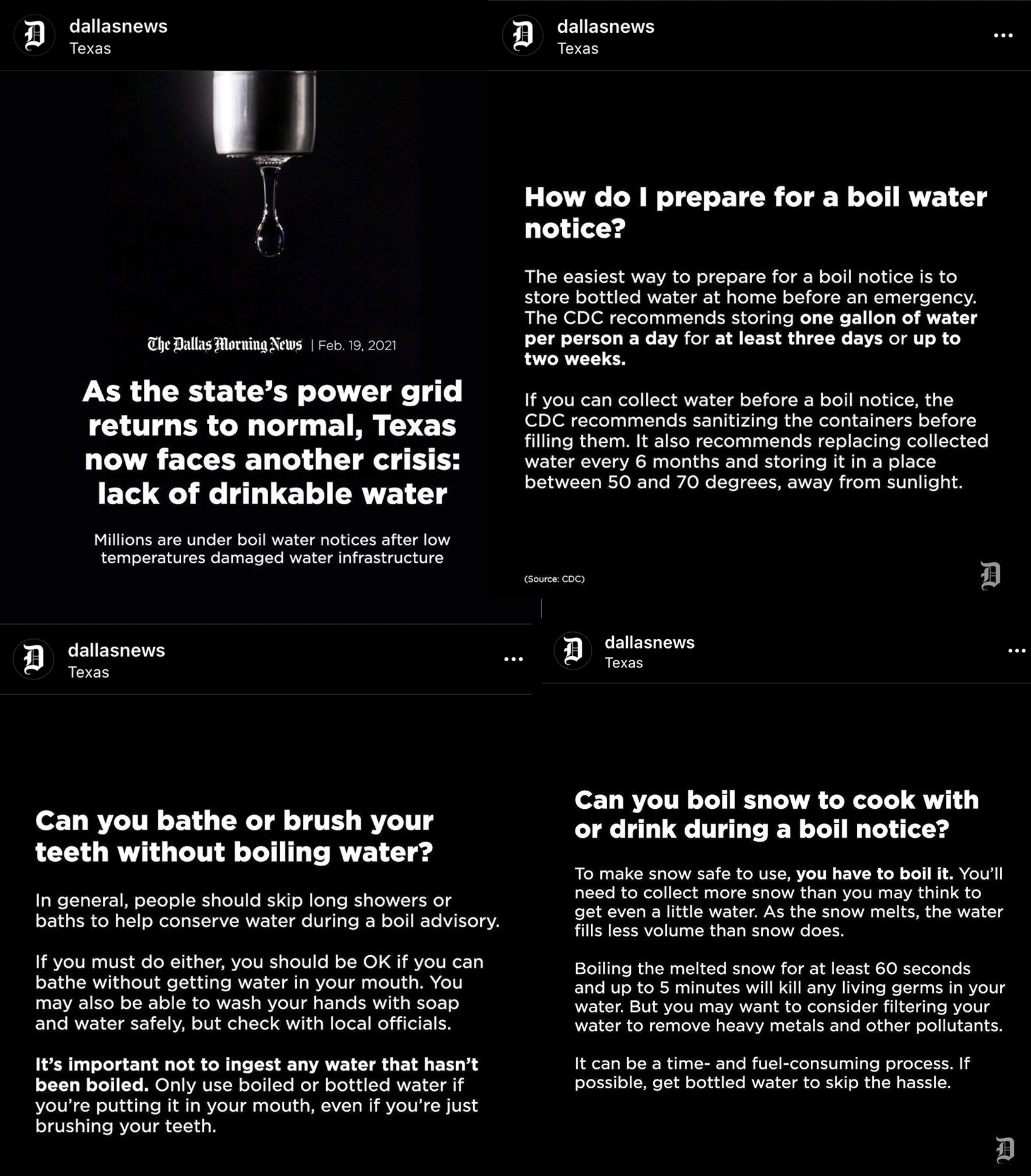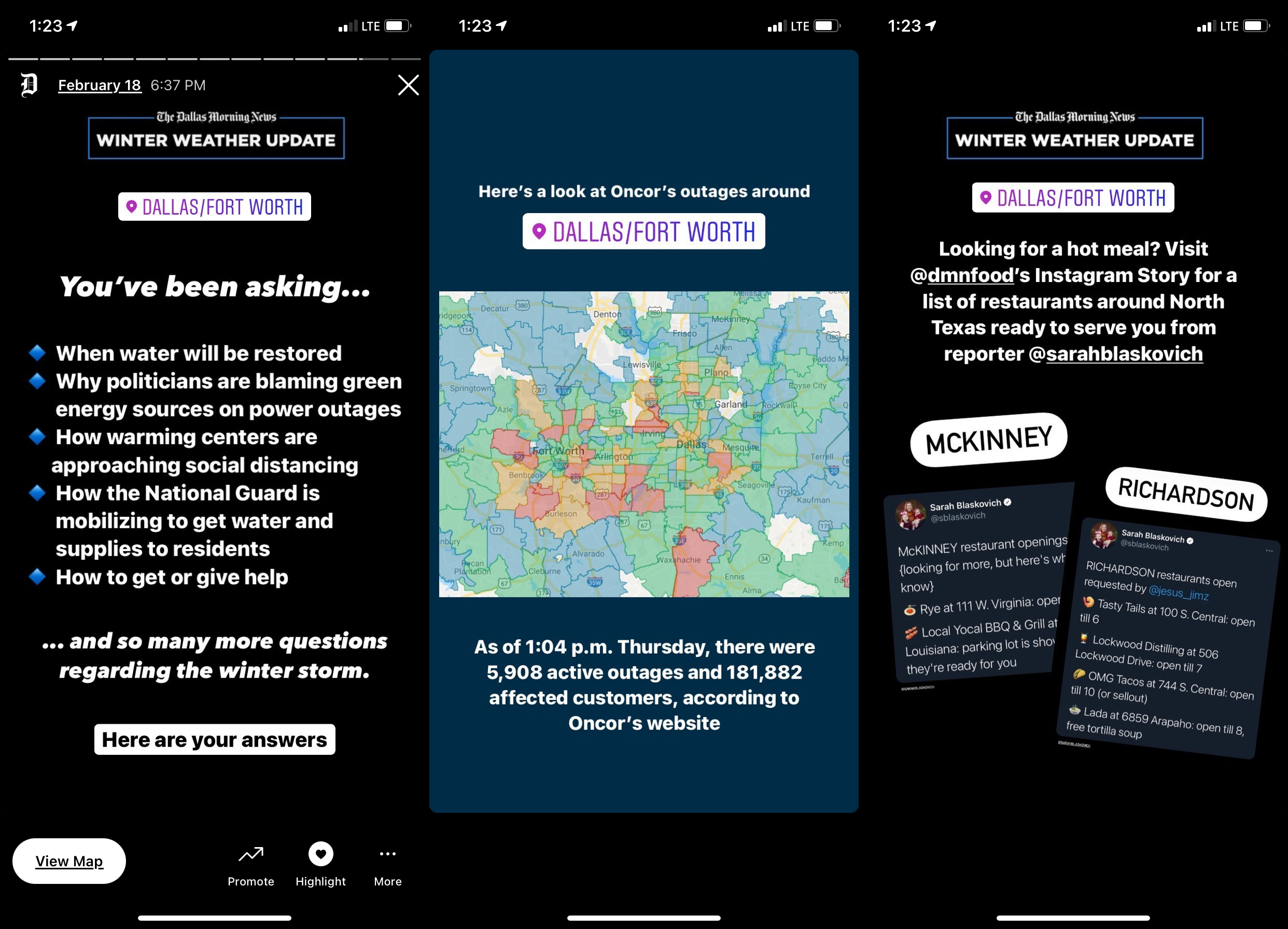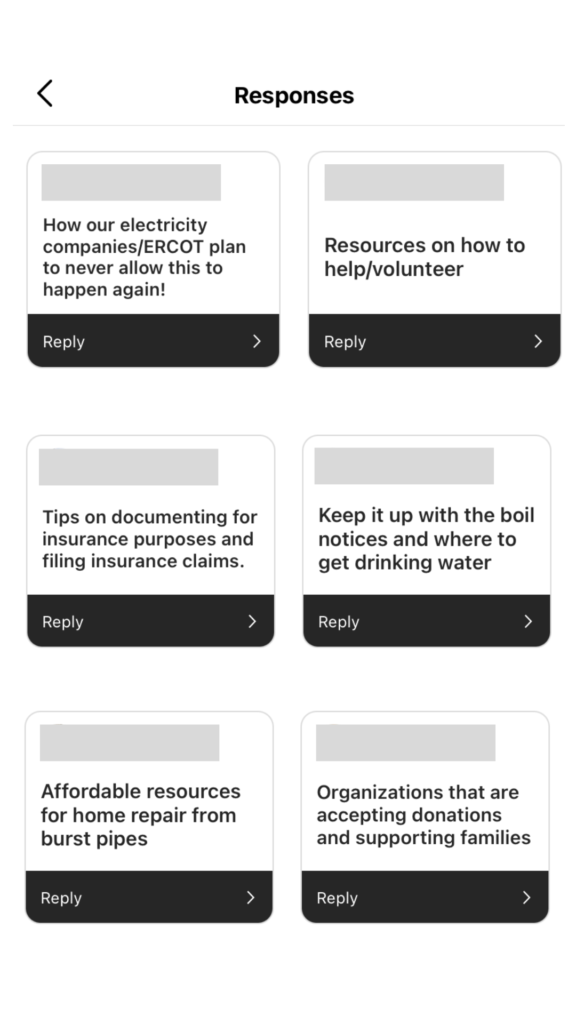How the Dallas Morning News’ Instagram became a lifeline during the historic Texas winter storm
Mallorie Sullivan, Narda Perez and Ashley Slayton, The Dallas Morning News,This is a series on Better News to a) showcase innovative/experimental ideas that emerge from the Knight-Lenfest Newsroom Initiative and b) share replicable tactics that benefit the news industry as a whole. This “win” comes from former Audience Journalist Mallorie Sullivan, Audience Journalist Narda Perez, and Audience Development Editor Ashley Slayton, at The Dallas Morning News, which participated in the Major Market Table Stakes program in 2015-16.
Question: What communities do you serve and what can you tell us about the history of your organization?
Answer: Founded in 1885, The Dallas Morning News is Texas’ leading news organization and is the winner of nine Pulitzer Prizes. It has one of the largest newsrooms in the Southwest. In 2015, The News was in the first group of news organizations to participate in the Table Stakes program. Since then, The News has been a leader in digital innovation among local news organizations.
On our flagship and secondary Instagram accounts, our primary focus is educating readers in North Texas about news and policies that impact them and the communities they live in. Our feed is full of explainer posts that highlight key elements of larger analysis articles. People come to the DMN Instagram account to learn more about what’s happening in their community, but they also come to get a better understanding of complex news of the day.
Q: What problem were you trying to solve, and why was solving the problem strategically important for your organization?
A: In February 2021, a historic Texas winter storm left thousands without power and water during sub-freezing temperatures. Readers turned to The Dallas Morning News as a resource for vital information. We wanted our readers to know they were being heard. We also wanted the journalism we produced to reflect their concerns.
We needed a way to listen quickly to our audiences during a prolonged, major breaking news event. So we used Instagram to engage with our readers. Our Instagram audience is one of the most highly-engaged and responsive audiences we have. Instagram’s suite of tools also makes it a natural fit for quickly engaging with readers. We benefited just as much from that exchange as readers did because their responses helped us produce the coverage they needed in the moment.
As an organization, our newsroom has made strides to focus on reader engagement. In 2017, we partnered with Hearken to launch Curious Texas, an initiative that involves readers in the reporting process. Since then, we’ve tried to extend that philosophy to everything we do.
Q: How is this approach related to Table Stakes (e.g. one of the 7 Table Stakes and/or an outgrowth of the Knight-Lenfest initiative, etc.)?
A: This approach relates to Table Stakes No. 2 (Publish on the platforms used by your targeted audiences).
Q: How did you go about solving the problem?
A: Instagram is a discovery tool, but local news on Instagram is informational, personality-driven and all about utility. We knew that people would turn to Instagram and other social platforms to find the latest storm-related updates. Our challenge was finding the right way to connect with them, to create the news they wanted to receive and to do it in a way that was relatable for them.
When the initial winter storm advisory was released, our six-member audience team — made up of audience journalists Carla Solorzano, Todd Davis, Mallorie Sullivan, Chelsea Watkins, Narda Perez and Ashley Slayton — got together to anticipate questions readers might have and what would be most useful to them.
Out of that, we generated several ideas, including a winter resources guide, advice from Texas transplants, an SMS weather alert, breaking weather newsletters, and a daily roundup on Facebook and Twitter.
The Instagram Winter Weather Update was born.
Because Texas doesn’t usually see winter weather at this extreme level, we created several how-to posts for the grid and Instagram Stories, including how to drive in snow and how to conserve energy in cold weather to relieve the strain on the power grid.
Once we got in the thick of the storm, we started answering questions such as how to stay warm when the power goes out and how to tell if an individual is experiencing symptoms of hypothermia. Many of these explainers had relatively long shelf lives, so we were able to keep sharing them with relevant posts to continue to help our readers throughout the storm.

The Dallas Morning News created created explainers for Instagram based on the questions readers asked about the winter storms. (Instagram screenshots courtesy of The Dallas Morning News)
We created explainers based on the questions readers asked, like this post explaining rolling outages, which was shared 8,900 times. After the posts appeared in our feed, we later shared them to our Instagram Stories. We also posted weather updates from the field to our Instagram Stories, and we asked our audience what sort of information would be the most useful to them as they turned toward recovery. We used the location and question stickers in our Instagram stories to better target and serve the needs of specific communities. We leveraged Instagram’s tools to drive people back to our site.
At times, we created content exclusively for Instagram that hadn’t yet been reported, such as information about power outages for small communities and water supply locations, because news was breaking so fast.

The Dallas Morning News leveraged the power of Instagram Stories beyond the “swipe up” link to get crucial information out quickly during the historic winter storms. (Instagram screenshots courtesy of The Dallas Morning News)
We also leveraged the power of Instagram Stories beyond the “swipe up” link to get crucial information out quickly. We linked to several stories to help readers find the most up-to-date stories in their communities, but we also were able to give readers a closer, more authentic look at how the storm was progressing throughout the area with short video updates from our reporters around the region.
We offered promo codes to readers who were not subscribers so they could access the content. We always accompany any distribution of promotional codes with a strong push to subscribe to our journalism.
When power went out across the state, we began adding regional and statewide power restoration maps to our Stories so our readers without electricity knew how it was progressing. As the outages continued, we began posting information for where to find warming centers, how to follow boil orders and where to find a hot meal around the area. We made sure to note specific communities so readers knew that information on our website was tailored to them.
That was all made possible by listening to our audiences. We received thousands of comments and direct messages from readers throughout the storm, and once we noticed trends in their questions and in their interactions on our posts and Stories — particularly through shares — we began creating posts based on what they were asking in ways that were designed to share with their own audiences to expand our reach.
Many of our staff members continued coverage of the storm despite dealing with power outages in their own homes and other issues during the storm.
That helped The News’ Instagram become a lifeline for thousands of readers across Dallas-Fort Worth and beyond during one of the state’s biggest storms.
Q: What worked?
A: Listening to our audiences and anticipating their questions. Making sure we were answering what they needed to know as well as what they wanted to know in palatable, easy-to-share ways throughout the storm, and continuing on through the aftermath was key to our success.
Doing that helped us gain more than 20,000 new followers over the span of two weeks and helped us drive more than 77,000 page views to the site from Instagram alone.
It was also integral to helping our followers — many of whom are younger or new to Texas and just beginning their relationship with us — stay informed about the news on a platform they are native to, in a way that makes sense to them. That, in turn, is an important step in strengthening the trust between us and our next generation of readers.

The Dallas Morning News team used responses to questions in Stories and direct messages to learn what its audiences wanted to know more about. (Instagram screenshot courtesy of The Dallas Morning News)
Q: What didn’t work?
A: One thing we learned is that callouts soliciting reader input need to be specific and unambiguous. You need to be intentional about the action you’re asking people to take. For example, a broad question like, “What questions do you have about power outages?” is likely to result in dozens of replies from readers wanting to know when outages will lift in their specific neighborhood.
Being targeted and intentional in your approach helps you get meaningful feedback from which you can take action. It’s important to devote enough resources to engaging with readers on Instagram. A small team can quickly become inundated. Instead, we looked to your inbox for guidance. If 10 people are asking the same question, there are likely many more wondering the same thing.
It’s also important to have a plan for how to handle the aftermath of prolonged breaking news. In hindsight, we needed a stronger strategy for how to address readers’ lingering questions after the storm passed. We shared a lot of analysis pieces following the storm that examined flaws in the state’s power grid, ERCOT, and the state’s readiness to handle major weather events. Analysis pieces are often very dense and breaking them down for social can be a challenge. Partnering with journalists in your newsroom for Q&As to dive deeper into reader questions about accountability and prevention can be extremely beneficial to readers.
Q: What happened that you didn’t expect?
A: We did not foresee our Instagram account becoming such an important, and for some, the only source of information for North Texans and beyond during the winter storm. We saw several readers mention that, even after the power went out, they were still able to access Instagram and that our account was how they were able to stay up-to-date with the latest information on the storm and its aftermath.
Another thing we didn’t expect was the impact we’d have on out-of-state readers. We heard from a lot of people who live in Texas that people they follow on Instagram who live out of state were sharing our posts to their Stories to help spread the word about the storm. It’s truly a testament to the power of Instagram as a news delivery vehicle, particularly for local news.
Q: What would you do differently now? What did you learn?
A: In the event of another breaking news situation, we would temporarily embed a journalist who is a subject-matter expert into the team and conduct more video/live Q&As with experts and officials.
Specifically, we would identify a journalist in the newsroom who could work exclusively with the audience team before the breaking news event. We’ve found it’s more efficient to identify that person ahead of time. Having that person embedded with the team enhances the quality of the work we produce.
This person can help answer some of the more difficult questions readers pose, such as specifics about weather patterns and the history of the Texas electrical grid. They can participate in live Q&A sessions with readers or reach out to sources, such as public officials, for real-time updates or to conduct video interviews.
Q: What advice would you give to others who try to do this?
A: Anticipate what readers are going to want to know about a certain situation or topic and leverage simple, explainer-style posts to break down the information. If you’re unsure where to begin, ask yourself: What would I want to know about this particular thing? These kinds of posts are not only useful for disseminating news in a quick, easy-to-digest way, they’re also shareable and help get your story in front of individuals who may not yet follow you.
Also, listen to your readers, ask them questions and have conversations with them. That is how you discover what they’re interested in and ways your organization can better serve them on Instagram. It’s so easy to work only on posts or Stories we think are interesting or necessary in the moment. But by reading and answering the comments, replying to DMs and using different native tools on Instagram, we were able to plan our social content as best we could to benefit readers in the moment and long-term.
This strategy of service journalism is what has allowed our Instagram following to grow by 72% last year from 124,000 followers to 213,000. We’ve employed the above tactics during elections, different phases of COVID-19 vaccine rollouts and citywide protests.
Q: Is there anything else you’d like to add?
A: Don’t have an active audience in your news organization’s comments or DMs? Take a look at the metrics — and go beyond the “likes.”
An open dialogue with our readers in the comments and DMs certainly helped our approach, but our success during this particular time hinged largely on watching which feed and Story posts were shared most often and how.
We’ve noticed that many of our readers on Instagram want to help their peers, and part of that is through sharing helpful information. Paying close attention to that helped solidify our strategy both on the feed and in Stories because we knew that’s what readers wanted without even asking them.